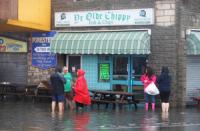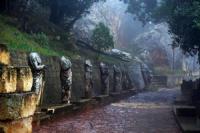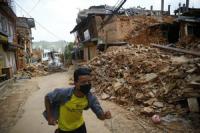-
Earthquake early warning vital for city transit
Although no one can reliably predict earthquakes, today’s technology is advanced enough to rapidly detect seismic waves as an earthquake begins, calculate the maximum expected shaking, and send alerts to surrounding areas before damage can occur. This technology is known as “earthquake early warning” (EEW). An EEW system called “ShakeAlert” is being developed and tested for the West Coast of the United States.
-
-
Monitoring critical minerals to ensure national preparedness
In 2014, the Defense Logistics Agency (DLA) came to a startling conclusion: The United States needed to increase its stockpile of a basic manufacturing material with military applications — yttrium oxide, a material used in laser rangefinders. This shortfall meant that in 2014, the DLA had to submit a request to Congress to acquire new material for the National Defense Stockpile. The DLA has a watch list of about 160 materials, and economists at the agency have developed an early warning system that let them concentrate on high-priority materials.
-
-
U.K. airports, nuclear power stations on terror alert following “credible” threat
Airports and nuclear power stations in the United Kingdom have been instructed to bolster their defenses against terrorist attacks in the face of intensified threats to electronic security systems. Security services have issued a series of alerts over the weekend, warning that terrorists may have developed ways of bypassing safety checks. U.S. and British security services are concerned that terrorists will use the techniques they developed to bypass screening devices at European and U.S. airports, against other critical infrastructure facilities such as nuclear power stations.
-
-
Managed retreat: Relocating communities to get them out of harm’s way
More frequent extreme weather events put certain regions in the cross hairs of risks such as coastal flooding, heavy rain, and erosion. There is an obvious, but controversial, solution: relocating communities from vulnerable to safer areas. Based on examples from around the world, researchers chart the landscape for whether and how to implement the strategy of managed retreat – and how, with the minimum disruption possible, relocate or abandon development in the face of extreme weather risks.
-
-
Sea level rise makes much of Honolulu and Waikiki groundwater vulnerable to inundation
Researchers found that a large part of the heavily urbanized area of Honolulu and Waikīkī is at risk of groundwater inundation — flooding that occurs as groundwater is lifted above the ground surface due to sea level rise. “Our findings suggest that coastal communities in Hawai’i and globally are exposed to complex groundwater flooding hazards associated with sea level rise in addition to the typical concerns of coastal erosion and wave overtopping,” said one researchers. “Groundwater inundation will require entirely unique adaptation methods if we are to continue to live in and develop the coastal zone. Coastal planners and community stakeholders will need to work with architects, engineers, geologists, ecologists, economists, hydrologists and other innovative thinkers in order to manage these problems.”
-
-
Past quakes at Calif. fault portend abrupt sinking of Seal Beach wetlands
A new study shows evidence of abrupt sinking of the wetlands near Seal Beach caused by ancient earthquakes that shook the area at least three times in the past 2,000 years — and it could happen again, the researchers say. The paleoseismology study reveals that the wetlands at the National Wildlife Refuge Seal Beach, a nearly 500-acre area located within the Naval Weapons Station Seal Beach and next to the communities of Seal Beach and Huntington Harbor, are susceptible to rapid lowering in elevation during large — over 7.0 magnitude earthquakes.
-
-
The old, dirty, creaky U.S. electric grid would cost $5 trillion to replace. Where should infrastructure spending go?

The electric grid is an amazing integrated system of machines spanning an entire continent. The National Academy of Engineering has called it one of the greatest engineering achievements of the twentieth century. But it is also expensive. By my analysis, the current (depreciated) value of the U.S. electric grid, comprising power plants, wires, transformers and poles, is roughly $1.5 to $2 trillion. To replace it would cost almost $5 trillion. That means the U.S. electric infrastructure, which already contains trillions of dollars of sunk capital, will soon need significant ongoing investment just to keep things the way they are. There is no path toward shoring up or upgrading the U.S. electric grid that does not require investment – even just maintaining what we have will cost hundreds of billions, if not trillions, of dollars over the next decade. The bigger question is: As we continue to replace and rebuild this amazing grid, what technologies should we focus on?
-
-
Extreme sea levels could endanger European coastal communities

Massive coastal flooding in northern Europe that now occurs once every century could happen every year if greenhouse gas emissions continue to rise, according to a new study. New projections considering changes in sea level rise, tides, waves and storm surge over the twenty-first century find global warming could cause extreme sea levels to increase significantly along Europe’s coasts by 2100. Extreme sea levels are the maximum levels of the sea that occur during a major storm and produce massive flooding.
-
-
Offshore fault system could produce onshore magnitude 7.3 quake in southern California
A fault system that runs from San Diego to Los Angeles is capable of producing up to magnitude 7.3 earthquakes if the offshore segments rupture and a 7.4 if the southern onshore segment also ruptures, according to a new analysis. “This system is mostly offshore but never more than four miles from the San Diego, Orange County, and Los Angeles County coast,” says the lead author. “Even if you have a high 5- or low 6-magnitude earthquake, it can still have a major impact on those regions which are some of the most densely populated in California.”
-
-
Knowledge gaps on protecting cultural sites from climate change

Researchers searched worldwide for peer-reviewed studies of cultural resources – archaeological sites, natural landscapes, and historic buildings — at risk due to climate change. About 60 percent of the studies referenced sites in Europe, most commonly in the United Kingdom. Another 17 percent of the research covered sites in North America, a majority of them in the United States. About 11 percent dealt with resources in Australia and the Pacific Islands and 10 percent mentioned Asia, mostly China. All but six of the 124 studies were published in English-language journals, with South America and Africa rarely represented in the research. “We see a significant gap in knowledge of how to adapt to climate change and preserve cultural resources for future generations,” says one researcher.
-
-
Better communication key to reducing earthquake death toll

A major problem in conveying earthquake risks to the public is that scientists are unable to predict when, where, and with what strength the next earthquake will strike. Instead, they use probabilistic forecasting based on seismic clustering. Earthquake experts have long grappled with the problem of how to convey these complex probabilities to lay persons.
-
-
California's San Joaquin Valley still sinking
Since the 1920s, excessive pumping of groundwater at thousands of wells in California’s San Joaquin Valley has caused land in sections of the valley to subside, or sink, by as much as 28 feet (8.5 meters). This subsidence is exacerbated during droughts, when farmers rely heavily on groundwater to sustain one of the most productive agricultural regions in the nation. Long-term subsidence is a serious and challenging concern for California’s water managers, putting state and federal aqueducts, levees, bridges, and roads at risk of damage. Already, land subsidence has damaged thousands of public and private groundwater wells throughout the San Joaquin Valley. Furthermore, the subsidence can permanently reduce the storage capacity of underground aquifers, threatening future water supplies.
-
-
Oroville dam danger shows how Trump could win big on infrastructure
This near catastrophe at Oroville dam — America’s tallest dam — is just the latest symptom of the chronic ill-health of America’s civil infrastructure, which has suffered from decades of under-investment and neglect. But the Oroville dam crisis could provide an unexpected opportunity for the new Trump administration to take on both problems – and win. The main problem in dealing with U.S. infrastructure is money, as up to $1 trillion would be required to repair or replace ageing dams, bridges, highways, and all the other components that support modern civilization. But there is a way for Trump to harness market forces and persuade corporate investors to invest in U.S. infrastructure. The Oroville dam near catastrophe demonstrates that some of the largest imminent threats to infrastructure will increase through climate change, and provides compelling evidence of the hard economic costs of inaction on infrastructure. If Trump moves away from climate change denial and accepts the strong balance of scientific evidence and opinion about human contribution t climate change, then a pathway to dealing with U.S. infrastructure could open up by appealing to “natural capitalism” – a market-driven economics which centers on the value of natural resources. Accepting man-made climate change could provide Trump with a chance to deliver on one of his major campaign promises, change the face of capitalism, and perhaps even save the world along the way.
-
-
Calculating climate change losses in major European coastal cities
A new study that assesses potential future climate damage to major European coastal cities has found that, if, as currently, global carbon emissions continue to track the Intergovernmental Panel on Climate Change’s worst emission scenario (RCP8.5), overall annual economic losses may range from $1.2 billion in 2030 to more than $40 billion by 2100. The study focused on nineteen major European coastal cities including Istanbul, Rotterdam, Barcelona, Hamburg, London, Dublin, Marseille, St Petersburg, and Copenhagen.
-
-
Fewer grain dust explosions reported in U.S. in 2016
The number of grain dust explosions in the United States fell to a 10-year low in 2016, but two of the incidents resulted in the first reported fatalities since 2013, according to an annual report released by Purdue University’s Department of Agricultural and Biological Engineering. There were five grain dust explosions in 2016, compared to eight in 2015 and a 10-year average of 9.2 per year.
-
More headlines
The long view
Helping Strengthen America’s Critical Infrastructure
Everyday life depends on a robust infrastructure network that provides access to running water, communications technology and electricity, among other basic necessities. The experts who keep our national infrastructure secure and resilient also need a strong network to share their knowledge and train the next generation of professionals capable of solving complex infrastructure challenges.
AI and the Future of the U.S. Electric Grid
Despite its age, the U.S. electric grid remains one of the great workhorses of modern life. Whether it can maintain that performance over the next few years may determine how well the U.S. competes in an AI-driven world.
